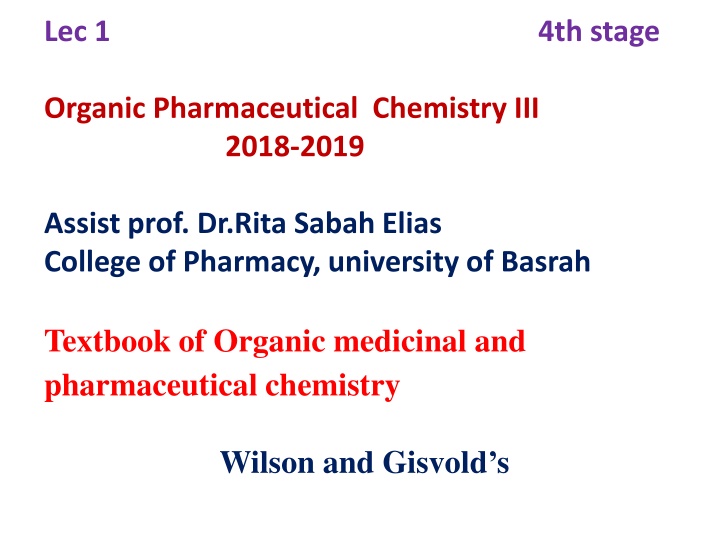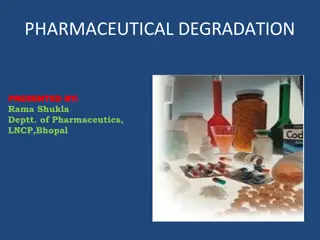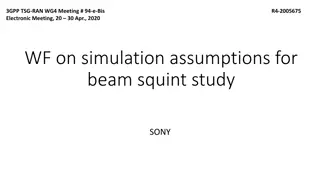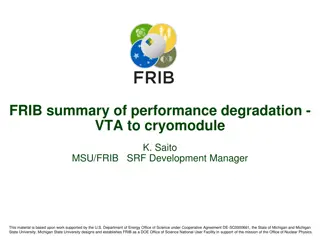Stereochemical Aspects of Penicillin Degradation Pathways
Penicillin undergoes complex degradation in both acidic and basic mediums, resulting in various inactive products. The degradation pathways involve rearrangements and hydrolysis reactions that lead to the formation of penicillenic acid, penamaldic acid, penillic acid, and penilloic acid. These processes are influenced by the pH of the solution and impact the stability and efficacy of penicillin as an antibiotic.
Download Presentation

Please find below an Image/Link to download the presentation.
The content on the website is provided AS IS for your information and personal use only. It may not be sold, licensed, or shared on other websites without obtaining consent from the author.If you encounter any issues during the download, it is possible that the publisher has removed the file from their server.
You are allowed to download the files provided on this website for personal or commercial use, subject to the condition that they are used lawfully. All files are the property of their respective owners.
The content on the website is provided AS IS for your information and personal use only. It may not be sold, licensed, or shared on other websites without obtaining consent from the author.
E N D
Presentation Transcript
Lec 1 4th stage Organic Pharmaceutical Chemistry III 2018-2019 Assist prof. Dr.Rita Sabah Elias College of Pharmacy, university of Basrah Textbook of Organic medicinal and pharmaceutical chemistry Wilson and Gisvold s
According to CA The carbon atom bearing the acylamino group (C-6) has the L- configuration, whereas the carbon to which the carboxyl group is attached has the D- configuration. Thus, the acyl amino and corbonyl groups are trans to each other, wtih the former in the and the latter in the orientation relative to the penam ring system. The absolute stereochemistry of the penicillins is designated 3S:5R:6R.
Penicillin hydrolysis in acidic and basic medium Acidic medium
In strongly acidic solutions (pH <3), penicillin undergoes a complex series of reactions leading to various inactive degradation products . The first step appears to involve rearrangement to the penicillenic acid. This process is initiated by protonation of the -lactam nitrogen, followed by nucleophilic attack of the acyl oxygen atom on the -lactam carbonyl carbon. The subsequent opening of the -lactam ring destabilizes the thiazoline ring, which then also suffers acid- catalyzed ring opening to form the penicillenic acid. The latter is very unstable and experiences two major degradation pathways. The most easily understood path involves hydrolysis of the oxazolone ring to form the unstable penamaldic acid. Because it is an enamine, penamaldic acid easily hydrolyzes to penicillamine (a major degradation product) and penaldic acid. The second path involves a complex rearrangement of penicillanic acid to a penillic acid through a series of intramolecular processes that remain to be elucidated completely. Penillic acid (an imidazoline-2-carboxylic acid) readily decarboxylates and suffers hydrolytic ring opening under acidic conditions to form a second major end product of acid-catalyzed penicillin degradation penilloic acid.
Basic medium Penicilloic acid, the major product formed under weakly acidic to alkaline (as well as enzymatic) hydrolytic conditions, cannot be detected as an intermediate under strongly acidic conditions. It exists in equilibrium with penamaldic acid, however, and undergoes decarboxylation in acid to form penilloic acid. The third major product of the degradation is penicilloaldehyde, formed by decarboxylation of penaldic acid (a derivative of malonaldehyde).
Bacterial Resistance The most important biochemical mechanism of penicillin resistance is the bacterial elaboration of enzymes that inactivate penicillins. Such enzymes, which have been given the nonspecific name penicillinases, are of two general types:- 1- -lactamases. 2- acylases. The more important of these are the -lactamases, enzymes that catalyze the hydrolytic opening of the -lactam ring of penicillins to produce inactive penicilloic acids.
-lactamases Acylases
Allergy to Penicillins rashes to penicillin, fever and anaphylaxis, constitute the major problem associated with the use of this class of antibiotics. 1- 10% of the population show signs of this allergic response, this may be due to the formation of penicillin antigen as outline below.
Evidence suggests that rearrange product (penicillenic acid ) formed in vivo react with lysine -amino group of serum proteins to form antigenic penicilloyl protein.























